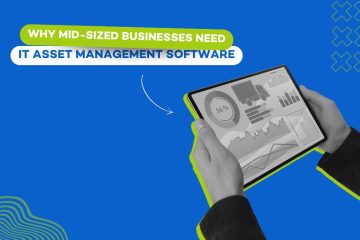Introduction
As technology becomes more integrated into everyday business operations, the management of IT assets has grown increasingly important. From hardware such as computers and servers to software licenses and cloud services, the number of IT assets a business must manage has grown exponentially. To avoid spiraling costs and inefficiencies, businesses are turning to IT asset management software to gain control over their resources. This software helps organizations track, manage, and optimize the use of their IT assets, ultimately leading to significant cost savings. In this blog, we’ll explore how IT asset management software can help businesses reduce costs and improve operational efficiency.
The Importance of IT Asset Management
Without a proper system to track and manage IT assets, businesses often struggle with issues such as lost or underutilized assets, redundant purchases, and non-compliance with software licenses. These challenges not only drive up costs but also expose businesses to risks like security vulnerabilities and operational inefficiencies.
Implementing IT asset management software allows businesses to centralize asset tracking, optimize their use, and ensure compliance with legal and contractual obligations. As a result, businesses can reduce their expenses while improving productivity and operational efficiency.
How IT Asset Management Software Reduces Costs
1. Elimination of Redundant Purchases
One of the key benefits of IT asset management software is its ability to provide real-time visibility into a company’s IT assets. Many businesses, especially those with large operations or multiple departments, struggle with tracking what hardware and software are already in use. Without this information, companies often end up purchasing assets they don’t need.
By using asset management software, companies can avoid redundant purchases, saving money that would otherwise be spent on unnecessary hardware and software. For example, if a department requests new computers, the software allows managers to see whether other departments have unused devices that can be repurposed. This reduces wasteful spending and helps businesses make better use of their existing resources.
2. Optimized Software License Management
In many organizations, managing software licenses can be a complex and costly process. Companies often purchase more licenses than they need or fail to renew essential ones, leading to either wasted resources or potential compliance penalties.
IT asset management software helps businesses keep track of their software licenses, ensuring they remain compliant with vendor agreements. The software can also identify underused or unused licenses, allowing companies to reallocate or terminate them, thereby avoiding unnecessary expenses. In this way, businesses can optimize their software investments, ensuring that they only pay for what they truly need.
3. Improved Hardware Lifecycle Management
Hardware, such as computers, servers, and network devices, has a limited lifespan. Without proper management, businesses may hold on to outdated equipment that costs more to maintain than it would to replace. Alternatively, they might replace hardware prematurely, wasting valuable resources.
With IT asset management software, businesses can track the lifecycle of their hardware assets, including purchase dates, warranties, and expected end-of-life dates. This enables companies to plan for replacements and upgrades in a cost-effective manner, avoiding expensive emergency repairs and minimizing downtime. It also helps businesses avoid unnecessary hardware purchases by extending the lifespan of their existing equipment through regular maintenance and timely updates.
4. Reduced Maintenance Costs
Another major cost-saving feature of IT asset management software is its ability to monitor the condition and performance of IT assets. By keeping a close eye on the health of hardware and software, businesses can proactively address potential issues before they become major problems. For instance, the software can alert IT teams when a server is approaching its capacity limits or when a piece of hardware is nearing the end of its useful life.
Preventive maintenance is much more cost-effective than reactive maintenance. By addressing issues early, businesses can avoid the higher costs associated with emergency repairs, extended downtime, or complete asset failures. Furthermore, the software allows companies to schedule regular maintenance for their assets, helping them extend the lifespan of their equipment and avoid unnecessary replacements.
5. Better Asset Utilization
IT asset management software helps businesses maximize the use of their existing assets. Through real-time tracking, businesses can monitor how their assets are being used, identify underutilized resources, and redistribute them where needed.
For example, if certain software licenses are not being fully utilized in one department, they can be reallocated to another department that needs them more. Similarly, unused or underused hardware can be reassigned to employees who need it, reducing the need for new purchases. This optimization of asset utilization ensures that businesses get the most value out of their investments.
6. Streamlined Vendor and Contract Management
Managing vendor relationships and contracts is a crucial aspect of IT asset management. Many businesses struggle to keep track of their contracts, leading to missed renewal deadlines or unfavorable terms that result in higher costs.
IT asset management software centralizes all vendor and contract information, making it easy for businesses to track renewal dates, service agreements, and pricing structures. This ensures that companies can renegotiate contracts before they expire and avoid being locked into expensive agreements. Additionally, it helps businesses take advantage of early renewal discounts and prevent automatic renewals of services or licenses they no longer need.
7. Enhanced Compliance and Risk Management
Non-compliance with software licenses or industry regulations can lead to hefty fines and legal liabilities. IT asset management software helps businesses maintain compliance by tracking license usage, renewal dates, and regulatory requirements.
The software ensures that businesses stay within the terms of their software agreements and avoid the financial penalties associated with overuse or misuse of licenses. It can also track compliance with industry regulations, ensuring that businesses adhere to data privacy and security standards. By mitigating these risks, companies can avoid costly legal fees and maintain their reputation.
8. Lower Energy Costs
In addition to managing the financial aspects of IT assets, some IT asset management software solutions also track the energy consumption of hardware. By monitoring energy usage, businesses can identify energy-hogging equipment and implement more energy-efficient practices, such as turning off unused devices or upgrading to more energy-efficient models.
This reduction in energy consumption not only lowers utility bills but also supports sustainability initiatives, which are becoming increasingly important for businesses in today’s market.
Conclusion
In today’s competitive business landscape, cost reduction is more critical than ever. Implementing IT asset management software offers businesses a comprehensive solution for managing their IT resources more effectively. By eliminating redundant purchases, optimizing software licenses, improving hardware lifecycle management, and enhancing compliance, businesses can significantly reduce their operational costs.
For companies in Delhi, partnering with a software company in Delhi like DI Infotech can provide access to tailored IT asset management solutions that meet the specific needs of your business. By investing in the right tools, businesses can not only reduce costs but also improve operational efficiency, paving the way for growth and success in 2024 and beyond.



0 Comments